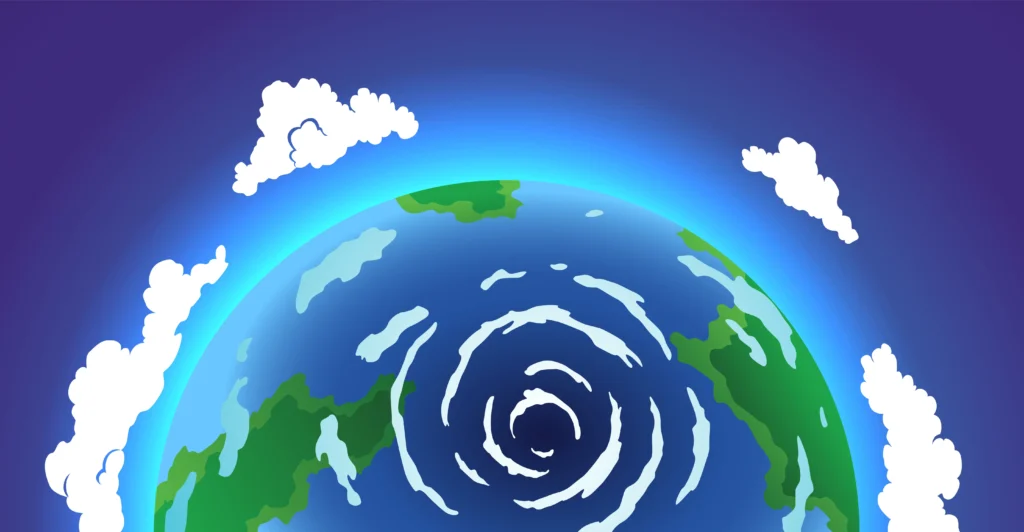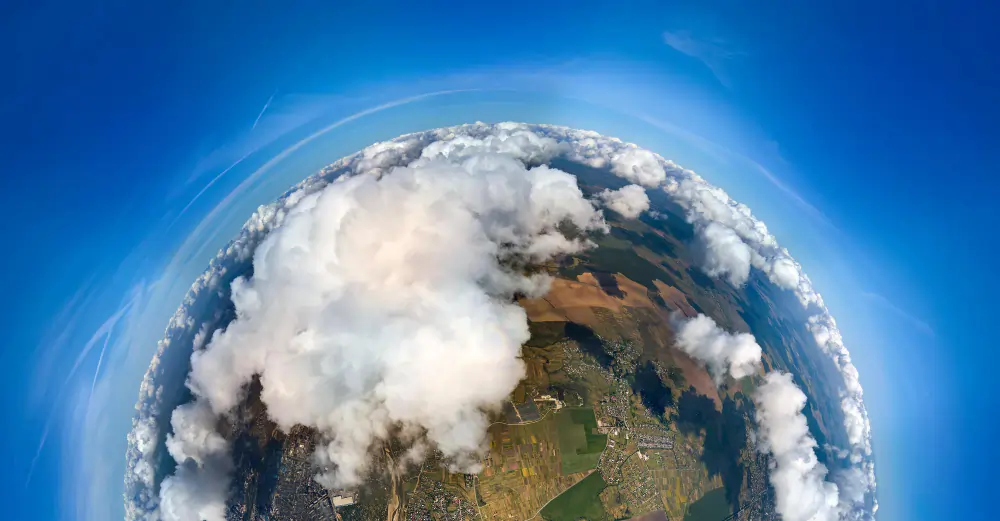Journey through time and discover the evolution of Earth’s atmosphere. From its fiery beginnings to the life-sustaining air we breathe, explore how volcanic eruptions, ancient life, and human actions shaped our world. Understand the forces that continue to change our atmosphere today.
⫸ The Earth's Early Atmosphere: Evolution of the Atmosphere
Our planet started with a vastly different atmosphere than the one we know today. Let’s delve into the origins of the Earth’s early atmosphere and the forces that shaped it, a key chapter in the ongoing evolution of the atmosphere.
Lack of a Primordial Atmosphere
Earth did not hold onto the light gases like hydrogen and helium that were abundant in the young solar system in its earliest days. Our planet’s initial gravity was too weak, and its temperature too high to retain these elements.
Formation of the Secondary Atmosphere
The atmosphere we recognize began to form through a process called outgassing. Molten rock within the young Earth held trapped gases like carbon dioxide, water vapor, and nitrogen. These gases and vast amounts of ash, heat, and other materials were violently released during volcanic activity.
Outgassing and Volcanic Activity
Intense and constant volcanic eruptions marked Earth’s early history. Outgassing released tremendous quantities of water vapor, which cooled and condensed to form the beginnings of our oceans. The early atmosphere was a choking mix of mainly carbon dioxide and nitrogen, with little to no free oxygen. This stage was pivotal in the evolution of the atmosphere.
⫸ Rise of Oxygen and the Great Oxygenation Event: Breathing Life into the World
Oxygen in our atmosphere makes Earth unique, but this life-giving gas wasn’t always around. Let’s explore the incredible events that transformed our planet.
Photosynthetic Organisms and Oxygen Production
The evolution of photosynthesis marked a turning point in the history of the Earth’s atmosphere. Early lifeforms, like cyanobacteria, developed the ability to harness sunlight to convert carbon dioxide and water into energy, releasing oxygen as a byproduct.
The Great Oxygenation Event: A Radical Shift
Around 2.4 billion years ago, a dramatic event known as the Great Oxygenation Event (GOE) occurred. Oxygen levels surged, forever altering the course of the Evolution of the Atmosphere. This oxygen initially reacted with dissolved iron and other materials in the oceans. However, it eventually began to accumulate freely in the atmosphere.
Implications for Life on Earth
The GOE had profound consequences. For existing anaerobic life, oxygen was toxic, leading to mass extinctions. However, it also paved the way for more complex lifeforms to evolve. Oxygen-based respiration is far more efficient, allowing the development of larger, more active organisms – eventually including ourselves!

⫸ Gases in the Atmosphere: A Delicate Balance
Our atmosphere isn’t just a mixture of gases; it’s a complex system in constant flux. Let’s explore the major players in the atmosphere and how they influence our planet’s climate.
Major Atmospheric Components: Nitrogen, Oxygen, Argon, and Others
- Nitrogen (N2): This inert gas makes up about 78% of our atmosphere, diluting oxygen and preventing overly-rapid combustion.
- Oxygen (O2): Oxygen is the lifeblood for most organisms on Earth. Oxygen comprises about 21% of the atmosphere, resulting from billions of photosynthesis.
- Argon (Ar): An inert gas making up nearly 1%, argon is largely a byproduct of radioactive decay within the Earth.
- Trace Gases: Many other gases, including the potent greenhouse gas carbon dioxide (CO2), exist in smaller amounts.
Carbon Dioxide's Influence on Climate
While present in small quantities, CO2 holds immense power. It traps heat radiating from the Earth’s surface, acting like a blanket to warm our planet. This natural “greenhouse effect” is what makes Earth habitable.
Greenhouse Effect and Climate Change
The concern with rising CO2 levels is that it throws the greenhouse effect out of balance. Human activities – burning fossil fuels in particular – have rapidly increased atmospheric CO2. This amplifies the greenhouse effect, leading to the global warming and climate change we’re experiencing.
⫸ Human Impact on Atmospheric Composition: A Legacy of Change
The Industrial Revolution marked a turning point in the evolution of the atmosphere. Unfortunately, human actions have triggered unprecedented changes that continue to reshape the air we breathe.
Industrialization and Rising Emissions
The widespread burning of fossil fuels – coal, oil, and natural gas – pumps massive quantities of carbon dioxide (CO2) into the atmosphere. Along with deforestation and other land-use changes, this disrupts the planet’s natural carbon cycle.
Pollution: Ozone Depletion and Smog
Industrial pollutants and vehicle emissions don’t just harm local air quality. Certain chemicals, like chlorofluorocarbons (CFCs), damage the protective ozone layer in the stratosphere. Meanwhile, gases like nitrogen oxides and volatile organic compounds react with sunlight, forming harmful ground-level ozone and smog.
Consequences of Altered Atmospheric Chemistry
The effects of humanity’s influence on the evolution of the atmosphere are far-reaching:
- Climate Change: Increased greenhouse gases trap heat, contributing to global warming and its cascading effects.
- Respiratory Health: Smog and air pollution severely impact human and animal health.
- Ecosystem Damage: Disrupted atmospheric chemistry can cause acid rain and harm plant and animal life.
⫸ Atmospheric Layers: Earth's Protective Shields
The atmosphere isn’t just a uniform blanket of air. It’s divided into distinct layers, each vital in making our planet habitable. Let’s explore these layers and why they matter in the evolution of the atmosphere.
The Troposphere: Where Weather Happens
This lowest layer is where we live and breathe. Reaching 10-15 kilometers above the surface, the troposphere contains most of our planet’s weather patterns, driven by the sun’s energy. Water vapor, clouds, rain, and snow originate in this dynamic layer.
The Stratosphere and the Ozone Layer
Rising above the troposphere lies the calm stratosphere. Here, a crucial component – ozone – protects against harmful ultraviolet (UV) radiation from the sun. This protective ozone layer played a key role in the evolution of the atmosphere, allowing life to move from the oceans onto land.
Upper Atmospheric Layers and Their Functions
Beyond the stratosphere lie the mesosphere, thermosphere, and finally, the exosphere fading into space. These higher layers absorb further radiation, protect us from space debris, and play roles in phenomena like the aurora borealis. The distinct temperatures and compositions of these layers demonstrate the continued complexity of the evolution of the atmosphere.
⫸ The Atmosphere: A Dynamic and Evolving System
Far from being a static layer, the atmosphere is in a constant state of change. Let’s explore the factors that make our atmosphere such a dynamic system.
The Earth’s atmosphere is never truly at rest. Its complex tapestry of forces and interactions continuously shapes and reshapes our air. Natural processes like volcanic eruptions, weathering, and even the very act of life contribute to this ceaseless change. This highlights a key point in the evolution of the atmosphere: it’s not simply Earth impacting the atmosphere, but the atmosphere and life-impacting each other.
Wind patterns, ocean currents, and solar radiation all drive the movement and mixing of atmospheric gases. These factors, along with ongoing human activity, ensure that the story of the evolution of the atmosphere is far from over; the forces of change are at work even as you read this.
⫸ The Present and Future of the Atmosphere: Challenges and Solutions
The evolution of the atmosphere didn’t end in the distant past – it’s happening right now. Let’s examine our atmosphere’s challenges today and the critical steps we must take to secure its future.
Challenges of a Changing Atmosphere on a Global Scale
Human activities have significantly altered the composition of our atmosphere, primarily by burning fossil fuels. This has led to rising levels of greenhouse gases, causing global warming and climate change. The consequences are far-reaching: melting ice caps, sea-level rise, extreme weather events, and disruptions to ecosystems.
Efforts Towards Reducing Pollution and Mitigating Climate Change
The good news is that the world is waking up to the situation’s urgency. Efforts are underway to transition to cleaner energy sources, reduce pollution, and develop technologies to remove carbon dioxide from the atmosphere. The shift towards renewable energy and sustainable practices is crucial in shaping the atmosphere’s evolution.
The Importance of International Cooperation
The atmosphere has no borders, and addressing climate change requires a united global effort. International agreements like the Paris Agreement provide frameworks for countries to collaborate in reducing emissions and adapting to the impacts of a changing atmosphere.
⫸ Conclusion: The Atmosphere – A Legacy of Change and Our Responsibility
The evolution of the atmosphere is a testament to the dynamic nature of our planet. From its fiery beginnings to the life-sustaining air we breathe today, the atmosphere’s story is one of unceasing transformation. Understanding this evolution is not merely an academic exercise; it’s a reminder that our choices today can shape tomorrow’s atmosphere.
Call to Action: Learn more about climate change and its impact on the atmosphere. Support initiatives that promote clean energy and reduce pollution. Even small changes in our daily lives can make a difference in the ongoing evolution of the atmosphere.

